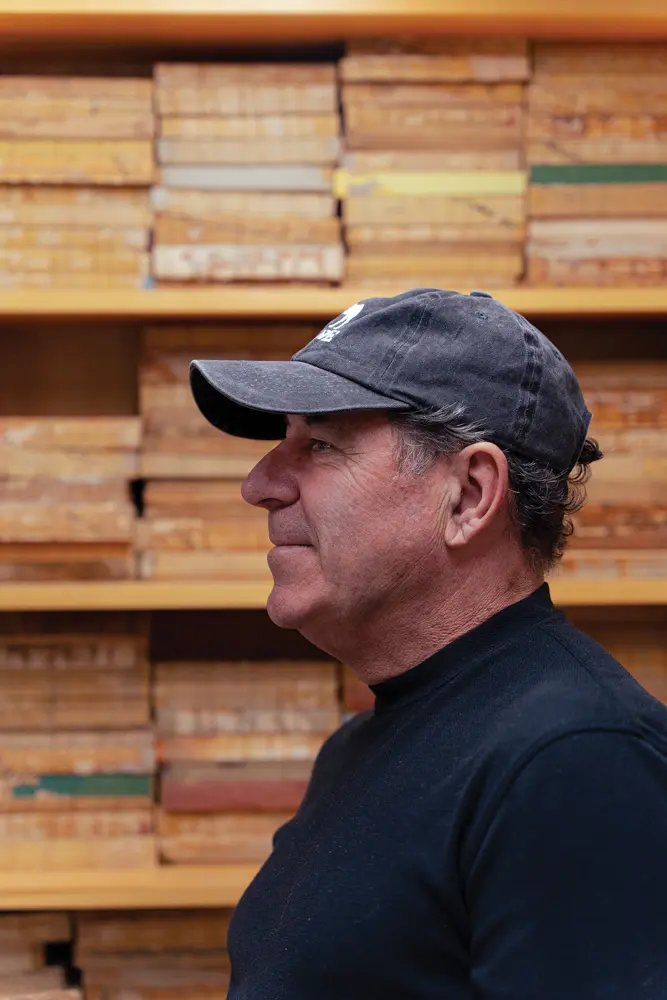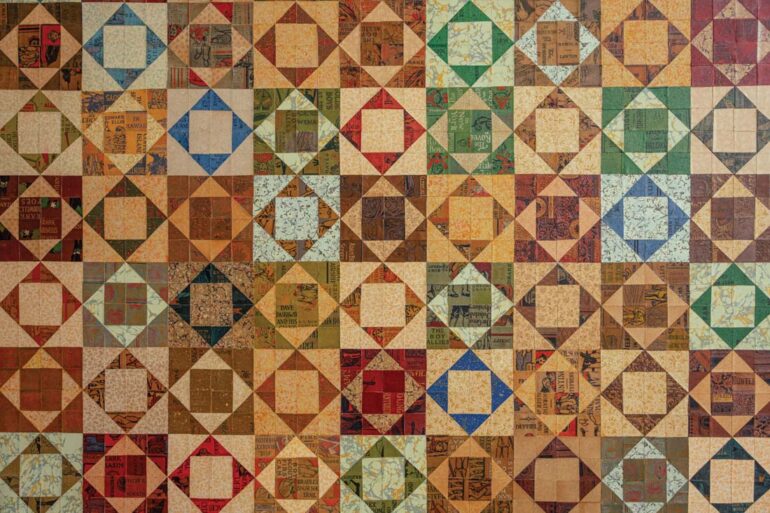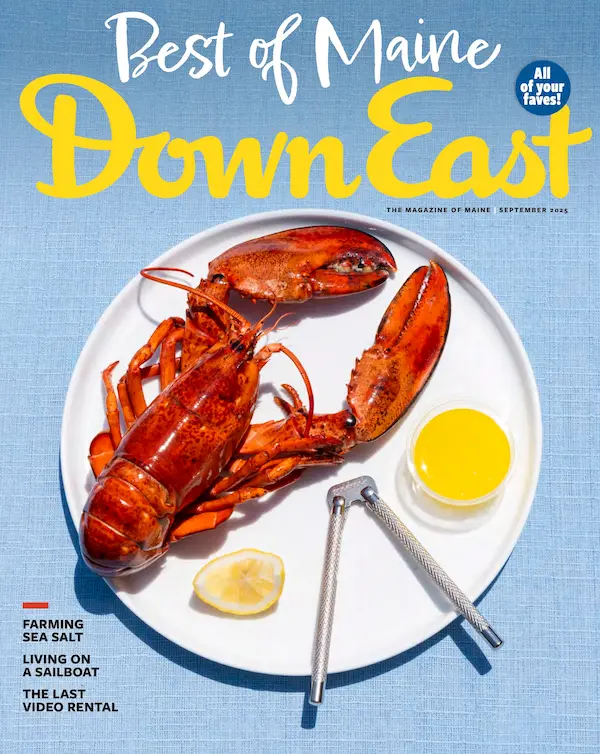By Virginia M. Wright
Photos by Chris Battaglia
From our January 2024 issue
In the basement of Larry Clifford’s Hampden home, scores of books squeeze together on shelves, flashing their naked, thready, pale-brown spines. The shredded remains of their covers are sorted by color in neat mounds on the worktable where Clifford practices his craft: cutting timeworn tomes into strips, triangles, squares, and circles and reassembling them as mosaics he calls biblioquilts. “I had so many old, decrepit books,” says Clifford, who at 65 is a grant writer by trade and artist by training and avocation. “I decided it was time to do something with them.” His studio name is inspired by the publisher’s term for a blank page at the beginning of a book: Flyleaf Gallery.

An avid reader, Clifford has been collecting tattered, outdated books from estate sales and library culls since he was a teenager living in Boston. The books’ subjects sometimes pique his curiosity, but he’s mostly drawn to their peculiar beauty — the faded covers with edges rubbed thin and tawny, the embossed line drawings, the yellowed pages with a long-ago reader’s enigmatic chicken scratches in the margins. “They have character,” Clifford says. “They remind me of cloth.”
Educated in the fine arts, Clifford’s first career was as a biomedical illustrator, meticulously executing anatomical studies by hand in carbon dust, pen-and-ink, and watercolor. When the field went digital in the 1990s, he lost interest and switched to healthcare business development and marketing. He emerged from his creative dormancy during the pandemic shutdown, when he took stock of the thousands of books stored in his basement. An admirer of handmade quilts, Clifford landed on patchwork art pieces as a way to preserve the books’ essences in an intriguing new form. Most of his volumes date to the early 1900s. They’re diverse, everything from medical tomes to young-adult novels, with one thing in common: they haven’t been read in decades. “As hard as it is to tear them apart, no one wanted them. Libraries couldn’t sell them — they were on their way to the dump,” Clifford says. He’s careful about what he designates as art materials — one of his bookcases is stocked with rare antiquarian volumes that his X-Acto blade will never touch.
Clifford’s biblioquilts are inspired by classic and contemporary quilt patterns. The geometric Geese Take Cover borrows from flying-geese designs, which use a series of triangles to suggest birds soar- ing through the sky. Spinal Columns, an abstract rendering of shelved books, employs the quilting technique of connecting long, thin strips to create a motif. Once he has a concept in mind, Clifford uses colored pencils to sketch it onto a foam board printed with a grid of one-inch squares. Next, he pastes the book scraps — the smallest are the triangular halves of one-inch squares — onto the board with craft glue. He coats the finished work with UV-resistant varnish and sets it in a maple frame with UV-resistant glass. Viewed from a few feet away, the patterns are rhythmic and harmonious. Up close, each tiny piece, with its fragments of text and illustration, is an intriguing riddle.
Volume Business
7,500
Clifford’s estimate of the number of books in his collection. “That’s very rough — I’ve never counted them.”
4,608
Number of triangles in Geese Take Cover, a four-by-four-foot pointillistic work in greens, oranges, and browns.
160
How many hours, on average, it takes to assemble a biblioquilt.
9
Geometric patterns in Clifford’s inventory. He’s currently working on his first design using free-flowing forms rather than lines and angles.
Since he began showcasing his work on Instagram two years ago, Clifford has been invited to display it in galleries, libraries, and bookstores throughout New England, and he’s currently working with the Mountain View Correctional Facility, in Charleston, to design a project that will involve inmates in creating a biblioquilt. His favorite projects are commissions for individuals who want mosaics made from books they’ve inherited from loved ones but rarely open. “These materials are precious,” Clifford says. “They can’t be reproduced.”









